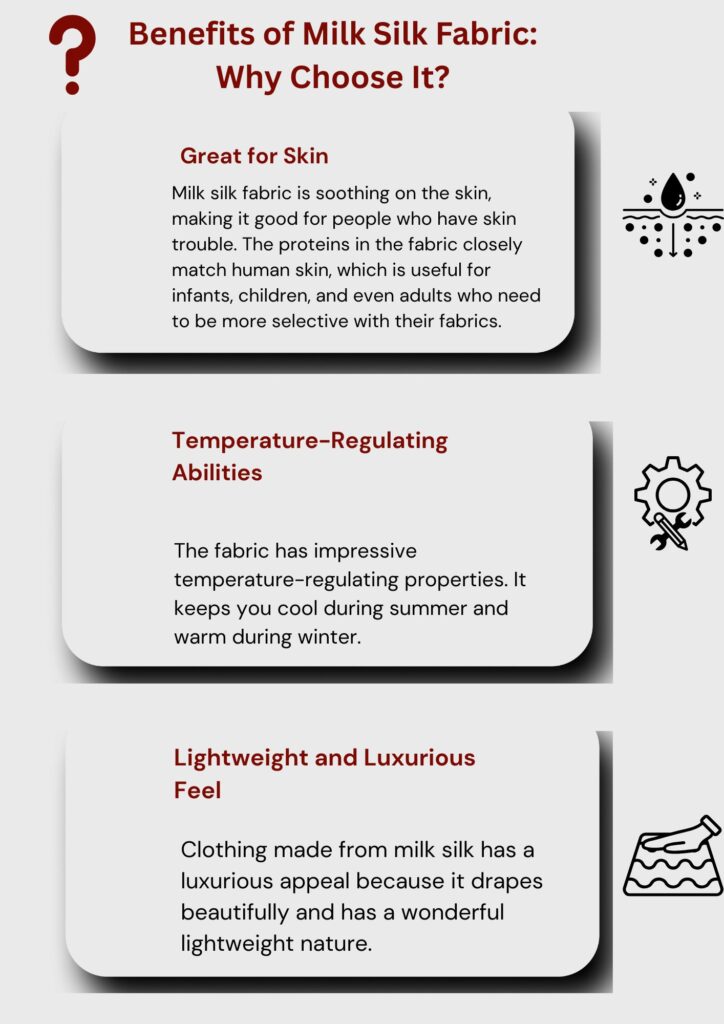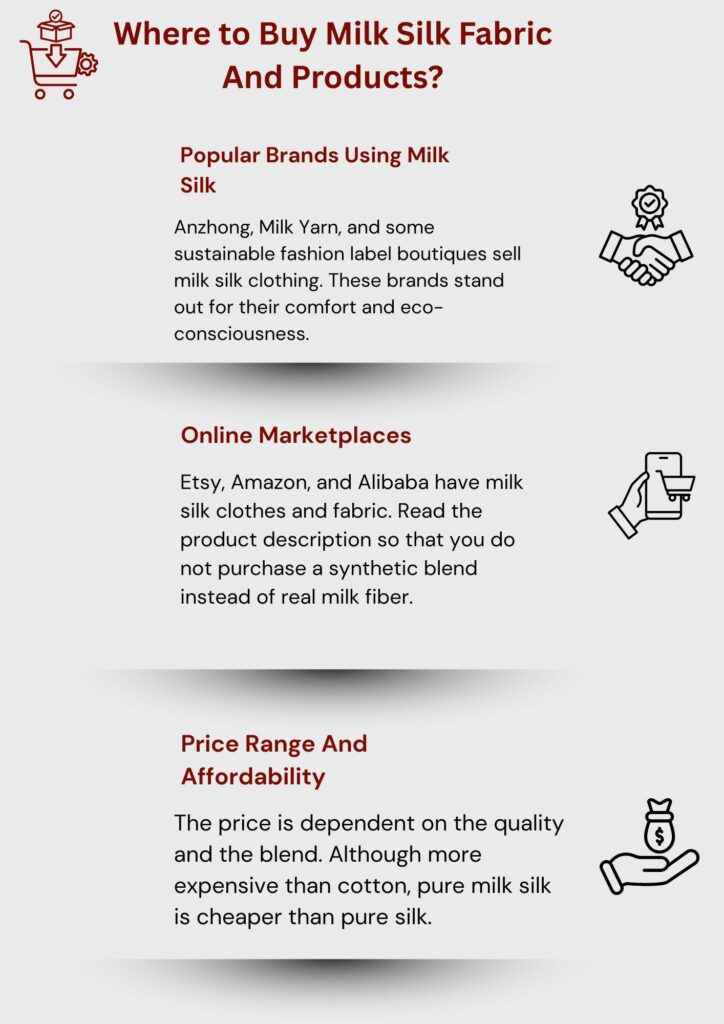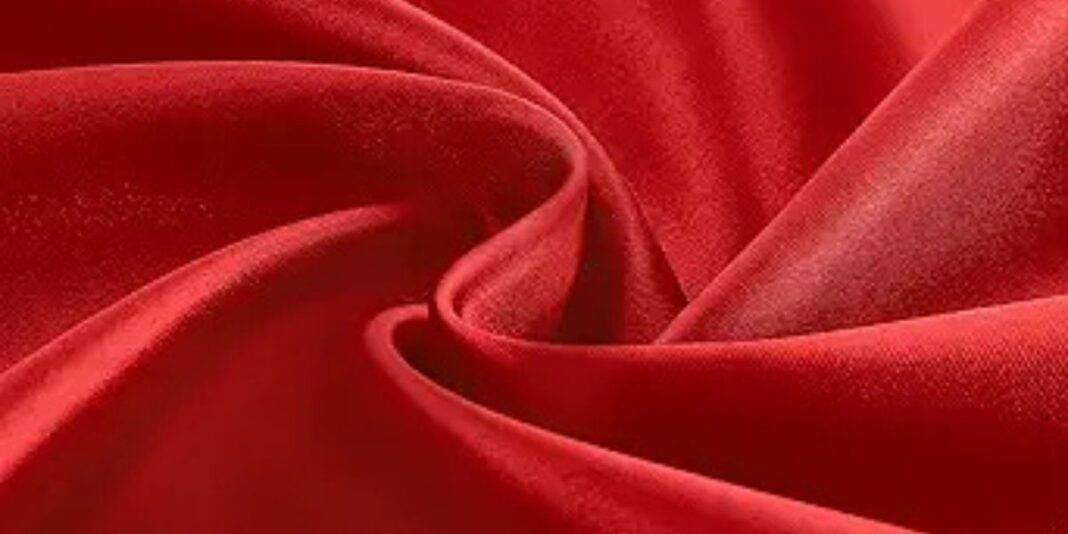Introduction
Like milk fiber or casein fiber, milk silk fabric refers to a collection of luxurious textiles made from milk protein. This fabric is created from casein, a protein that constitutes milk, and offers comfort and smoothness while being sustainable. Straddling the divide between eco-consciousness and luxurious craftsmanship, milk silk fabric offers a couture soft texture reminiscent of traditional silk.what is milk silk fabric
“Milk silk” captures the essence of its unique textile origin. The fiber is comprised of surplus or expired milk that cannot be consumed. Instead of being discarded, this resource is put to use by extracting casein to be spun to threads which are silky smooth. This innovative approach creates sustainable fabrics which feel luxurious.
Milk silk outmatches most traditional fabrics like cotton, silk or even bamboo. It is softer than cotton, shines just as evenly as silk and rivals bamboo in eco-friendliness. Though breathable like cotton and anti-bacterial like bamboo, milk silk uniquely melds these attributes with a luxurious feel to them.
How is Milk Silk Fabric Made? The Journey from Milk to Material
Fiber Production and Casein Extraction
The method starts with the skimming and dehydration of spoilt or surplus milk. In the case of liquid milk, this is treated to form casein, which is a protein found in milk. The extracted casein is dissolved to form a thick liquid which is recombined chemically before being spun into milk threads with specialized equipment, which is then dried, cured, and woven into fabric.
This change adds value to dairy waste by forming a high-value textile. Even though the steps are many, the process is less harmful when compared to the production of synthetic fibers.
Is the Process Eco-Friendly?
The process is largely eco-friendly as it burns less energy than cotton and uses less water and avoids the environment harming toxins that polyester is known for. This is also beneficial in the long run as it utilizes waste milk that would otherwise go to waste.
Chemical vs. Natural Processing Methods
Two approaches can be looked at here, those being chemical or natural. Chemical approaches may involve softening agents while treatments with natural enzymes falls into the natural category. In a bid to preserve the environment, sustainable brands prefer using these enzyme-based or closed-loop systems as they result in less pollution while leaning towards fabrics made from these processes.
Features and Qualities of Milk Silk Fabric
Texture and Softness
Milk silk is smooth and soft to such a degree that it gets confused with real silk. In comparison to cotton, it is smoother and more fine, while milk silk is softer than real silk and more elastic. Therefore, it is perfect for delicate, flowing garments or fitted pieces.
Breathability and Moisture-Wicking
As with other fabrics, its breathability is important. Like the best cottons and silks, it has good moisture-wicking properties which helps with sweat build-up. Whether sitting or on the move, milk silk makes sure to keep you feeling fresh.
Hypoallergenic and Antibacterial
Skin and allergy sufferers, including people with eczema, will benefit from such fabrics, as they are not only antibacterial but also hypoallergenic due to its amino acids.
Durability and Stretchability
Few would expect any fabric could possess such soft silks, and yet milk silk fabric retains its softness and has surprising durability. It not only retains its shape wash after wash but also has a slight give, providing comfort. This combination of softness and sturdiness is why milk silk is sought for garments.
Benefits of Milk Silk Fabric: Why Choose It?

Great for Skin
Milk silk fabric is soothing on the skin, making it good for people who have skin trouble. The proteins in the fabric closely match human skin, which is useful for infants, children, and even adults who need to be more selective with their fabrics.
Temperature-Regulating Abilities
The fabric has impressive temperature-regulating properties. It keeps you cool during summer and warm during winter. Milk silk is not like synthetic fabrics, as it controls temperature; rather it adjusts to your body temperature.
Lightweight and Luxurious Feel
Clothing made from milk silk has a luxurious appeal because it drapes beautifully and has a wonderful lightweight nature. Thus, it is frequently used in premium apparel, loungewear, and nightwear.
Low Environmental Impact of Silk
Additionally, unlike polyester and nylon, milk silk breaks down naturally and does not leave behind harmful residue. Its biodegradability makes it a smart choice for eco-friendly consumers.
Common Uses of Silk Fabric
Clothing for All Occasions
You can find wide use of silk fabric for clothing, especially T-shirts, dresses, undergarments, and loungewear. With its stretch and softness, milk silk is preferred both for daily wear and luxury fashion.
Comfortable Bedding
Its hypoallergenic and breathable characteristics make it suitable for bedding. Users of pillows and sheets with a covering of milk silk claim the covering offers a cool soothing experience that improves their sleep.
Babywear and Infant Clothing
The texture of milk silk makes it safe and ideal for baby clothes. Toddlers and newborns will appreciate the gentle touch of the fabric on their delicate skin.
Fabric blends with added functionality
Milk silk can be blended to enhance specific properties with spandex, cotton or modal. These blends increase durability, add stretch, create a specific feel while maintaining original benefits of milk silk.
Which is better Milk Silk and other Fabrics?
Milk Silk vs. Cotton
Although cotton is versatile and breathable, it has lower softness and elasticity compared to milk silk. Moreover, the production of milk silk is more eco-friendly than the water-intensive cotton. Although milk silk is more expensive than cotton, it provides a luxurious feel unlike any other.
Milk Silk vs Bamboo Fabric
Both fabrics are sustainable; however bamboo tends to be more fibrous while milk silk has a much silkier feel. On the other hand, bamboo has strong antibacterial properties which milk silk counters with its protein-rich base. In terms of luxury and feel, milk silk usually comes out ahead.
Silk Milk VS. Synthetic Fabrics
While polyester and nylon are durable, they do not offer comfort or environmental sustainability. On the other hand, milk silk is breathable and comfortable, along with being biodegradable. This makes it a far better option for both the skin and Mother Nature.
Care and Maintenance of the Milk Silk Fabric
Washing Instructions
To maintain the best possible condition for your milk silk items, hand wash them with mild detergent in cold water. If you need to use a washing machine, it is best to employ the delicate cycle and place the garments in a mesh laundry bag to avoid any potential damage.
Drying and Ironing Tips
Tumble drying can weaken fabrics, so it’s best to avoid it altogether. Instead, air dry either flat or hung up in the shade. If needed, ironing can be done on a low setting as long as a cloth barrier is used between the iron and fabric to prevent scorching.
Preventing Pilling and Damage
Gentle liquid detergents should be used. Additionally, milk silk clothing should not be worn or stored over rough surfaces to protect against pilling and damage. To maintain the garments’ shape and prevent stretching, they are best stored folded rather than hanging.
Is Milk Silk Fabric Sustainable and Ethical?
Eco-Friendly Manufacturing Process
The process of creating milk silk is eco-friendly because it utilizes waste milk. By utilizing waste milk, this process reduces food waste, as well as minimizing the environmental load associated with textile production.
Water and Energy Efficiency
Compared to traditional cotton or synthetic fibers, the production of milk silk uses significantly less water and energy. This also contributes to reducing the overall carbon footprint of the industry.
Vegan Considerations
As it is obtained from the animal’s milk, milk silk cannot be classified as vegan. There is concern regarding the welfare of animals in the dairy sector. That said, some people view it as a better option than synthetic fabrics because it utilizes spoiled and surplus milk.
Where to Buy Milk Silk Fabric And Products?

Popular Brands Using Milk Silk
Anzhong, Milk Yarn, and some sustainable fashion label boutiques sell milk silk clothing. These brands stand out for their comfort and eco-consciousness.
Online Marketplaces
Etsy, Amazon, and Alibaba have milk silk clothes and fabric. Read the product description so that you do not purchase a synthetic blend instead of real milk fiber.
Price Range And Affordability
The price is dependent on the quality and the blend. Although more expensive than cotton, pure milk silk is cheaper than pure silk. Expect to pay $15 to $30 per yard for fabric, or $25 to $100 for finished garments.
Conclusion
Milk silk fabric is a true blend of luxury, sustainability, and innovation. Its luxurious touch and breathability makes milk silk a fabric of consideration for every conscious consumer. For those on the hunt for sustainable fashion or comfort for sensitive skin, milk silk is an unmatched fabric.
FAQs
Not at all, milk silk is not real silk. It is a man made silk-like fabric created from the proteins derived from milk.
Absolutely! As long as it provides proper moisture-wicking, and breathable properties milk silk will always be great for summer.
Milk silk has the potential to slightly shrink if hot water is used for washing the garment or dried in a sum of energy. As long as care directions are followed there should be no issues.
As it uses casein, which is derived from milk, it does not fall under vegan friendly. Though the casein used is from milk that would otherwise not be put to use.
A fair amount of care will allow garments made from milk silk to have a life span extending over multiple years. When it comes to longevity, it is on par with a lot of natural fibers.


